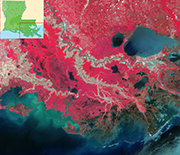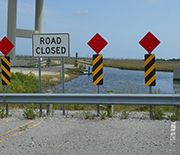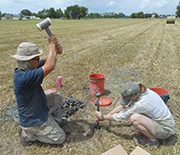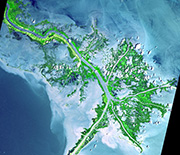News Release 18-026
Mississippi River diversions will produce new land, but more slowly than shoreline is lost
Study used optical dating to measure how fast the Mississippi Delta is moving

An eroding Mississippi Delta: How quickly is it washing away? Scientists have new answers.
April 11, 2018
This material is available primarily for archival purposes. Telephone numbers or other contact information may be out of date; please see current contact information at media contacts.
The best solution to sustaining portions of the Mississippi Delta may be river diversions that bring sediment to shrinking coastlines. However, a new study concludes that the rate of land-building will likely be dwarfed by the rate of wetland loss.
"Scientists studied how fast the Mississippi River Delta grew each year before people inhabited the area and began changing the environment," said Justin Lawrence, a program director in the National Science Foundation's Division of Earth Sciences, which funded the project.
"The researchers then compared that information with observations of how fast the delta is shrinking in modern times, and the results are striking. The findings will inform coastal policy and management in this low-lying U.S. region."
The study results, published today in the journal Science Advances, used optical dating to measure how fast the delta shoreline migrated seaward under natural conditions.
"Optical dating determines when sediment grains were deposited by measuring their last exposure to daylight," said Elizabeth Chamberlain of Vanderbilt University, the paper's lead author. "This method allowed us to date the shoreline of the Lafourche lobe of the central Mississippi Delta."
Prior to human influence, the delta grew at a rate of 2 to 3 square miles per year. But over the past century, the rate of land loss in coastal Louisiana has averaged 15 to 20 square miles per year.
Geologist Torbjörn Törnqvist of Tulane University, a co-author of the study, said that given accelerating rates of sea level rise, losses will likely continue long into the future, and that even the best-designed river diversions won't be able to prevent more land loss. "Therefore, difficult choices will have to be made about where to locate these diversions."
The only viable option, Törnqvist believes, is to position river diversions in areas that have the greatest potential to build land and protect the largest population centers, as opposed to placing multiple diversions along the entire shoreline.
Chamberlain and Törnqvist conducted the research with colleagues from Coastal Carolina University, the University of Liverpool in the United Kingdom and Wageningen University in The Netherlands.
Additional funding was provided by the Coastal Protection and Restoration Authority of Louisiana.
-NSF-
-
How much has the Mississippi Delta changed over time, and what might it look like in the future?
Credit and Larger Version -
Thanks to wetland loss, Louisiana Highway 1 along Bayou Lafourche abruptly ends in open water.
Credit and Larger Version -
Scientists Zhixiong Shen and Elizabeth Chamberlain collect a riverbank sample for dating.
Credit and Larger Version -
Elizabeth Chamberlain extracts a sample from a light-proof sampling device for optical dating.
Credit and Larger Version -
The Mississippi Delta today, shrinking as sea level rises and sand grains are carried away.
Credit and Larger Version
Media Contacts
Cheryl Dybas, NSF, (703) 292-7734, email: cdybas@nsf.gov
Barri Bronston, Tulane University, (504) 314-7444, email: bbronst@tulane.edu
The U.S. National Science Foundation propels the nation forward by advancing fundamental research in all fields of science and engineering. NSF supports research and people by providing facilities, instruments and funding to support their ingenuity and sustain the U.S. as a global leader in research and innovation. With a fiscal year 2023 budget of $9.5 billion, NSF funds reach all 50 states through grants to nearly 2,000 colleges, universities and institutions. Each year, NSF receives more than 40,000 competitive proposals and makes about 11,000 new awards. Those awards include support for cooperative research with industry, Arctic and Antarctic research and operations, and U.S. participation in international scientific efforts.
Connect with us online
NSF website: nsf.gov
NSF News: nsf.gov/news
For News Media: nsf.gov/news/newsroom
Statistics: nsf.gov/statistics/
Awards database: nsf.gov/awardsearch/
Follow us on social
Twitter: twitter.com/NSF
Facebook: facebook.com/US.NSF
Instagram: instagram.com/nsfgov







